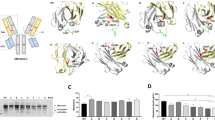Abstract
The water soluble long-chain crosslinker, sulfo-succinimidyl-6-[3′-(2-pyridyldithio)-propionamido]hexanoate (S-LC-SPDP) was used to prepare ricin A chain (RTA) immunotoxins constructed with whole IgG and Fab fragments of the anti-common acute lymphoblastic leukemia antigen (CALLA) monoclonal antibody. In this study, a) S-LC-SPDP modification efficiencies of whole IgG and Fab, b) conjugation yields of the immunotoxins prepared and c)in vitro immunoreactivity and cytotoxicity of immunotoxins constructed were examined. IgG-RTA and Fab-RTA immunotoxins were prepared with 67.3% and 57.0% conjugation yields, respectively. These long spacer intermolecular linked immunotoxins were selectively immunorective and cytotoxic against to immunogenic Daudi cells but little or no-binding and cytotoxic against to antigen K562 cells. Both IgG-RTA and Fab-RTA immunotoxins were 210- and 45-fold more active than intact RTAin vitro, respectively.
Similar content being viewed by others
References cited
Byers, V. S. and Baldwin, R. W., Targeted kill: From umbrellas to monoclonal antibodies.J. Clin. Immunol., 12, 391–405 (1992).
Carlsson, J., Drevin, H., and Axen, R., Protein thiolation and reversible protein-protein conjugation: N-succinimidyl 3-(2-pyridyldithio)propionate, a new hterobifuncational reagent.Biochem. J., 173, 723–737 (1978).
Chun, C. J. and Lee, K. C. Cytotoxicity of anti-CALLA monoclonal antibody conjugates to methtotrexate.Arch. Pharm. Res., 16, 347–348 (1993).
Derocq, J. M., Casellans, P., Laurent, G., Ravel, S., Vidal, H. and Jansen, F., Comparison of the cytotoxic potency of T101 Fab, F(ab')2 and whole IgG immunotoxins.J. Immunol., 141, 2837–2843 (1988).
Fitzgerald, D. J. P., Trowbride, I. S., Pastan, I. and Willingham, M. C., Enhancement of toxicity of anti-trasfemin receptor antibody-Pseudomonas exotoxin conjugates by adenovirus.Proc. Natl. Acad. Sci. USA, 80, 4134–4138 (1983).
Ford, C. H. J., Richardson, V. J. and Tsaltas, G., Comparison of tetrazolium colorimetric and [3H]-uridine assays forin vitro chemosensitivity testing.Cancer Chemo. Pharmacol., 24, 295–301 (1989).
Fulton, R. J., Uhr, J. W., Vitetta, E. S., The effect of antibody valency and lysosomotropic amines on the synergy between ricin A chain- and ricin B chain-containing immunotoxins.J. Immunol., 136, 3103–3109 (1986).
Lee, K. C., Lee, Y. J., Kim, W. B. and Cha, C. Y., Monoclonal antibody-based targeting of methotrexate-loaded microspheres.Inter. J. Pharm., 59, 27–33 (1990).
Lord, J. M., Hartley, M. R. and Roberts, L. M., Ribosome inactivating proteins of plants. In Lord J. M. (ed.),Seminars in Cell Biology, Saunders Scientific, Philadelphia, 1991, pp. 15–22.
Marsh, J. W. and Neville, D. M. Jr., A flexible peptide spacer increase the efficacy of holoricin anti-T cell immunotoxins.J. Immunol., 140, 3674–3678 (1988).
Olsnes, S., Pihl, Different biological properties of the two constituent peptide chains of ricin.Biochemistry, 12, 3131–3126 (1973).
Ross, W. C. J., Thorpe, P. E., Cumber, A. J., Edwards, D. C., Hinson, C. A. and Davies, J. S., Increased toxicity of Diphtheria toxin for human lymphoblastoid cells following covalent linkage to anti-(human lymphocyte) globulin or its F(ab')2 fragment.Eur. J. Biochem., 104, 381–390 (1980).
Stanker, L. H., Vanderlaan, M. and Juarez-Salinas, H., One-step purification of mouse monoclonal antibodies from ascites fluid by Hydroxylapatite chromatography.J. Immunol. Methods., 76, 157–169 (1985).
Stirpe, F., Olsnes, S. and Pihl, A., Gelonin, a new inhibitor of protein synthesis, nontoxic to intact cells, isolation, chracterization, and preparation of cytotoxic complexes with concanavalin A.J. Biol. Chem., 255, 6949–6953 (1980).
Thorpe, P. E., Cumber, A. J., Williams, N., Edwards, D. C., Ross, W. C. J. and Davies, A. J. S., Abrogation of the non-specific toxicity of abrin conjugated to anti-lymphocyte globulin.Clin. Exp. Immunol., 43, 195–200 (1981).
Uckun, F. M., Myers, D. E., Irvin, J. D., Kuebelbeck, V. M., Finnegan, D., Chelstrom, L. M. and Houston, L. L., Effect of the intermolecular toxin-monoclonal antibody linkage on thein vivo stability, immunogenicity and anti-leukemic activity of B43 (Anti-CD19) pokeweed antiviral protein immunotoxin.Leukemia and Lymphoma, 9, 459–476 (1993).
Youle, R. J., and Neville, D. M. Jr., Kinetics of protein synthesis inhibition by ricin anti-Thy 1.1 monoclonal antibody hybrids.J. Biol. Chem. 257, 1598–1601 (1982).
Author information
Authors and Affiliations
Rights and permissions
About this article
Cite this article
Woo, B.H., Lee, J.T. & Lee, K.C. Ricin A immunotoxins of IgG and Fab of anti-CALLA monoclonal antibody: Effect of water soluble long-chain SPDP on conjugate yield, immunoselectivity and cytotoxicity. Arch. Pharm. Res. 17, 452–457 (1994). https://doi.org/10.1007/BF02979124
Received:
Issue Date:
DOI: https://doi.org/10.1007/BF02979124




